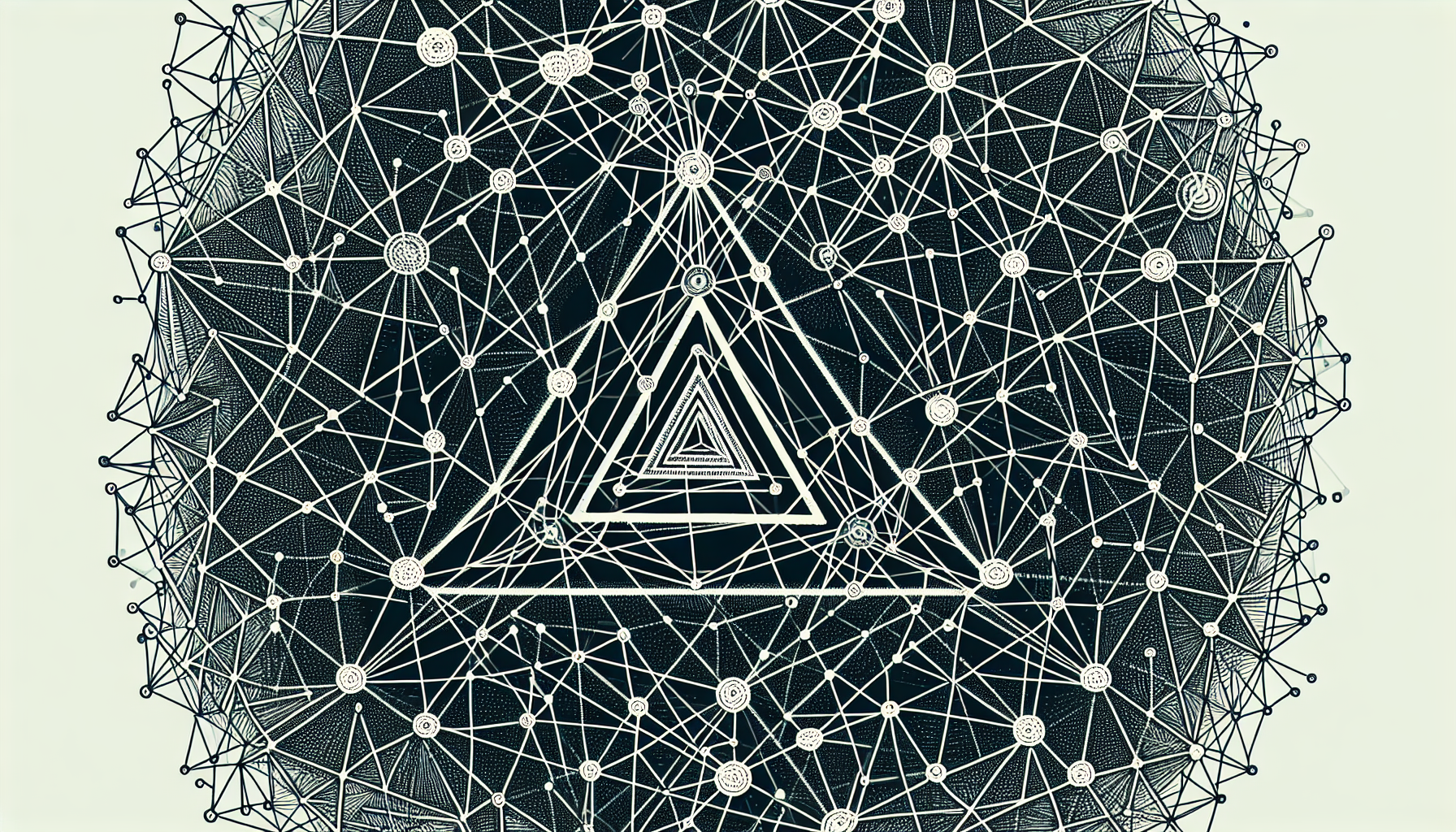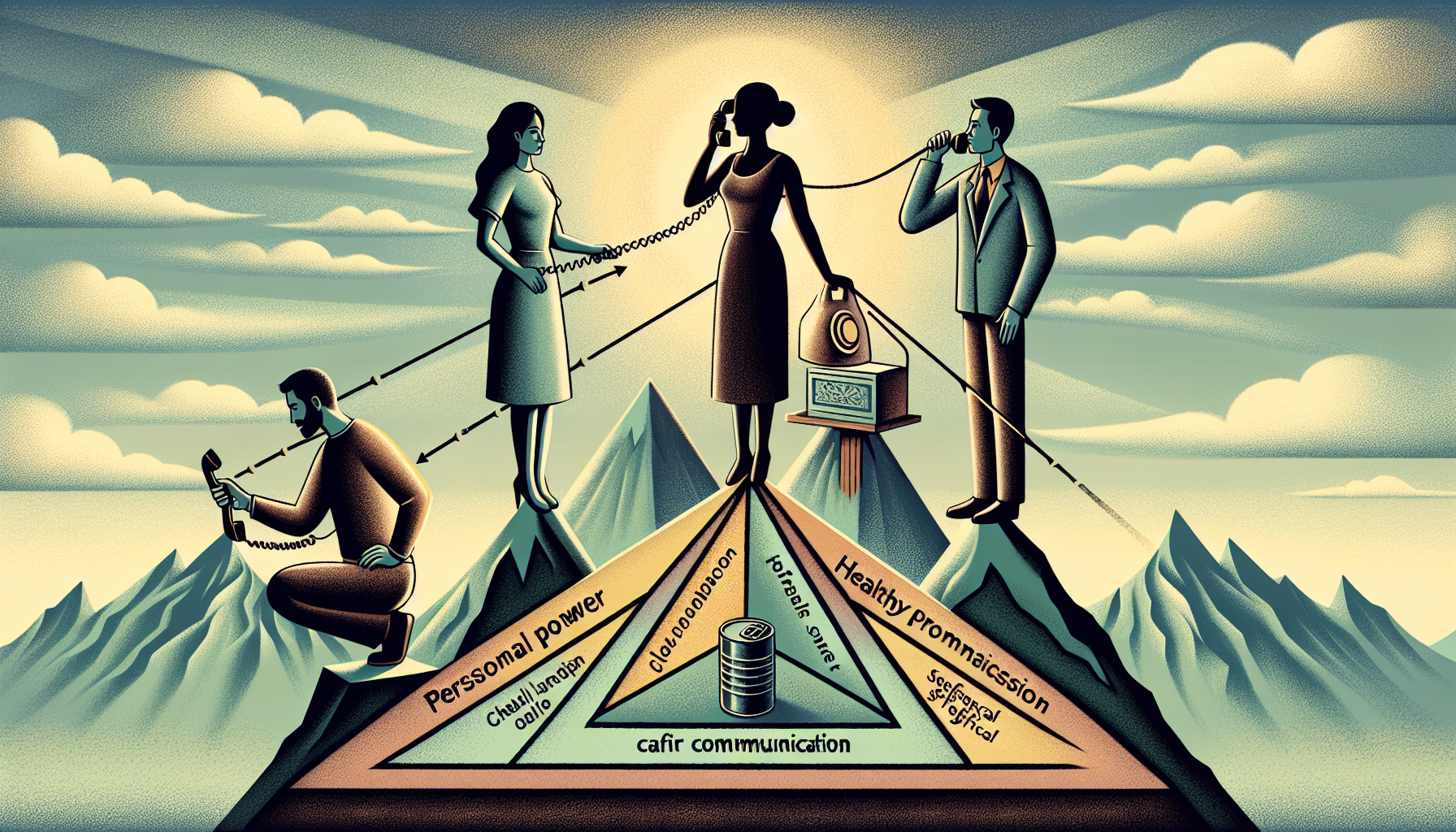Triangulation involves one person using a third party to manipulate and control relationships, often causing emotional turmoil and distrust. If you have ever felt caught in someone else’s conflict or seen relationships around you deteriorate due to hidden agendas, understanding triangulation is key. This article explores the effects of triangulation and offers strategies to cope with it, helping you protect your emotional well-being.
Key Takeaways
-
Triangulation involves manipulating or using threats of exclusion to control relationships, creating tension and distrust among the involved parties, and can lead to long-term emotional distress.
-
Common settings for triangulation include romantic relationships, family dynamics, workplace environments, and friend groups, where it manifests through favoritism, jealousy, rumors, and indirect communication.
-
Strategies to cope with triangulation include maintaining self-control, setting clear boundaries, seeking support from trusted individuals or professionals, and utilizing direct communication to resolve conflicts without involving third parties.
Understanding Triangulation: Effects and Strategies to Cope

Triangulation is a tactic where one individual uses manipulation or threats of exclusion to secure their goals or enhance their security within a relationship. This behavior can create tension and distrust among all parties involved. The purpose is to pit people against each other to better cement their own position or relationships. This strategy can create dysfunctional patterns and cycles within relationships, leading to long-term emotional distress and confusion for those involved. Some key points to remember about triangulation are:
-
It involves manipulation or threats of exclusion
-
It creates tension and distrust among all parties involved
-
The purpose is to pit people against each other
-
It can lead to long-term emotional distress and confusion
Those who practice triangulation typically utilize indirect communication, often speaking behind others’ backs primarily via the manipulator. They use manipulative tactics to control situations and fuel their need for attention and drama. Insecurity and avoiding direct confrontation are common traits among those who use triangulation. Effective coping involves maintaining self-control and not reacting impulsively.
Sometimes, indirectly addressing these behaviors can prove more effective than a direct confrontation, especially when people express their concerns in their own words.
Introduction
Triangulation in psychology is a manipulative strategy that involves a third person in a conflict between two people, frequently leading to emotional distress and relationship problems. This tactic is used by individuals to control the narrative and maintain power within a relationship. By involving a third member, the manipulator can create divisions and tensions that serve their own interests.
The involvement of a third person can make the targeted individuals feel isolated, insecure, and unsure of their standing in the relationship. This can lead to a breakdown in trust and communication, further exacerbating the emotional turmoil. For those seeking to safeguard their emotional health and maintain healthy relationships, it is vital to grasp how triangulation functions and learn to identify its signs.
What is Triangulation?

Triangulation refers to a manipulation tactic where one person brings a third party into a relationship to maintain control. It is used to divide and conquer by manipulating relationships, ensuring that the manipulator remains at the center of attention and power. In relationships involving triangulation, the two involved individuals communicate mainly through the manipulator, often leading to misunderstandings and conflicts.
This pattern of indirect communication is a hallmark of triangulation. The manipulator avoids direct interaction with the other person, using the third party as an intermediary. This can create a sense of confusion and instability, as the true intentions and feelings of the manipulator are often hidden. The purpose of triangulation is to pit people against each other to better cement the manipulator’s position or relationships.
One effective method to combat triangulation is to take a step back and assess the situation objectively. Cultivating a healthy balance of open and honest communication with others can also help avoid engaging in triangulation. Confronting triangulation directly may allow the manipulator to win by provoking a reaction, so it is often better to address the behaviors indirectly.
Common Examples of Triangulation
Triangulation can appear in various forms but always involves dividing people against each other. This tactic can manifest in various types of relationships, including those with:
-
friends
-
family members
-
romantic partners
-
coworkers
It is worth being aware of its potential impact across different areas of life. In all these contexts, the goal is the same: to create discord and maintain control by playing people against each other.
Examples of triangulation include favoritism in family dynamics, creating jealousy in romantic relationships, and spreading rumors in workplace or friend groups. These scenarios illustrate the manipulator’s use of a third party to control and influence the interactions and emotions of those involved. Recognizing these patterns is the first step in protecting oneself from such manipulative tactics.
Romantic Relationships

In romantic relationships, triangulation can involve bringing in a new romantic interest or friend to create jealousy and discord. For instance, a partner might flirt with someone else to make their significant other feel insecure and jealous. This can create a toxic environment where one partner is constantly trying to win back the affections of the other, often at the cost of their own emotional well-being.
Another common manipulation tactic is comparing a partner unfavorably to an ex, which can manipulate and control them. This can make the manipulated partner feel insecure and worry about being abandoned for someone else, leading them to work harder to accommodate the manipulator’s needs and desires. Such dynamics can severely impact the emotional health and stability of the relationship.
Family Dynamics

Triangulation in families can manifest in different ways, such as:
-
The golden child-scapegoat dynamic, where one child is idealized and another is devalued. A parent might designate one child as the favorite and the other as the scapegoat, creating a divide between siblings.
-
The parent-child alliance, where one parent aligns with one child against the other parent or sibling.
-
The parent-child coalition, where one parent aligns with one child against the other parent or sibling.
These dynamics can lead to long-term emotional scars, hurt feelings, and strained relationships within the family.
Another example is when a parent refuses to maintain a healthy family environment, instead pitting two siblings against each other to garner more attention or control. This tactic can create a dysfunctional family unit, where children feel pressured to compete for the parent’s approval and affection. Such dynamics can disrupt the healthy development of children’s personalities and their ability to form positive relationships in the future.
Workplace and Friend Groups
Triangulation can also occur in workplace settings, where it can create a hostile environment. For example, a manager might communicate with employees through a third party instead of directly, leading to miscommunication and tension. This can result in a toxic work culture where employees feel distrustful and divided.
Among friends, triangulation can involve:
-
spreading rumors to isolate one member and cause division within the group
-
leading to a breakdown in trust and friendships
-
creating a scenario where individuals feel manipulated and unsure of their standing within the group
Recognizing such behaviors is crucial for maintaining healthy and supportive relationships.
Causes and Motivations Behind Triangulation
Triangulation typically arises from a communication breakdown due to issues such as shyness, lack of assertiveness, and passive-aggressive behavior. These issues make direct conflict resolution difficult, leading individuals to resort to indirect methods of managing relationships. By deflecting tension and creating additional conflicts, manipulators can maintain control and avoid direct confrontation.
Individuals with narcissistic personality disorder (NPD) often use triangulation as a manipulative tactic to maintain control in relationships. Narcissistic triangulation is used to increase feelings of supremacy, secure self-esteem, and reinforce a sense of superiority. The narcissist devalues one individual while drawing another closer, using both parties as sources of narcissistic supply. This helps them maintain dominance by driving wedges in relationship dynamics.
People with borderline personality disorder (BPD) may also use triangulation to avoid feelings of abandonment. They create animosity between individuals, hoping that their target will rely on them for support and love. Insecurity is a common trait among people who use triangulation, as they seek to feel a greater sense of security in relationships.
Psychological Impact of Triangulation

Triangulation can lead to psychological effects such as diminished self-esteem, self-doubt, and increased susceptibility to further manipulation. Narcissistic triangulation can leave individuals feeling off-balanced, insecure, and doubting themselves. This can make them feel humiliated, defensive, or worried about what others think of them, leading to the urge to confront those involved.
Triangulation can also have several negative effects, including:
-
Impacting the target’s self-esteem
-
Making them doubt their relationships with friends and family
-
Potentially causing self-isolation and vulnerability to abuse
Additionally, the third member in triangulation can feel pressured or manipulated, creating stress, confusion, and anxiety for those involved.
Recognizing Signs of Triangulation
To recognize triangulation, one must identify instances where a manipulator controls communication. Triangulation often involves indirect communication, usually behind someone’s back. A key sign of triangulation is when you are asked to take sides on a specific issue. Feeling pressured to choose who’s right during a conflict is a common indicator of triangulation.
Another sign is when one person in the relationship feels entirely ignored or rejected. The two involved individuals typically communicate mainly through the manipulator, which can create a sense of confusion and instability. Being aware of these signs can help individuals recognize and address triangulation before it causes significant harm.
Recognizing signs of triangulation in a romantic relationship is crucial, especially when dealing with a narcissistically inclined person. This manipulation tactic often involves a baiting person who subtly creates competition among the people involved, leading to jealousy and discord. In romantic partnerships, triangulated individuals may feel jealous or excluded as the narcissistically inclined person shares private confidences with one person to manipulate another. It’s a common tactic used by those with personality disorders, and directly confronting the manipulation tactics can help in navigating these complex dynamics within personal personality disorders and romantic relationships.
Roles in Triangulation Manipulation

In relationships involving triangulation manipulation, distinct roles emerge:
-
The Victim, who is being emotionally triangulated, manipulated, gaslit, and abused
-
The Persecutor, the person who is manipulating, controlling the narrative, and pulling the strings
-
The Rescuer, who often confuses the Persecutor with the Victim and enables the Persecutor’s abuse
In triangulation manipulation, it is often very difficult for outsiders to discern who is the Victim and who is the Persecutor. The roles often get confused, and the Victim often ends up looking like the Perpetrator. Comprehending these roles can facilitate the identification, recognition, and breaking free from manipulation tactics in relationships.
The Victim
The Victim in triangulation, often referred to as the triangulated individual, typically exhibits the following behaviors:
-
Appearing unhinged, angry, confused, dysregulated, panicked, and impulsive
-
Experiencing emotional manipulation and gaslighting
- Usually has a self-sacrifice or subjugation schema
-
Being confused and potentially trauma-bonded to the Persecutor
-
Struggling to discern whether they are being emotionally manipulated, often unaware or just becoming aware of it
-
Struggling to gain genuine support due to misrepresentation
-
Feeling helpless and wronged
-
Being covertly baited and provoked by the Persecutor into acting like the Perpetrator, thereby confirming the Persecutor’s narrative
-
May be engaging in reactive abuse
The Persecutor
The Persecutor in triangulation can be either overt or covert. In triangulation manipulation, the Persecutor often looks like the Victim to the outside world. They:
-
Control the narrative and manipulate others
- Usually has an Entitlement/Grandiosity schema or a Mistrust/Abuse Schema
-
Use criticism, gaslighting, or aggression to establish dominance
-
Engage in covert baiting and provoking of the Victim
-
Manipulate the Rescuer into believing they are the Victim
-
Often exhibit traits of Narcissistic Personality Disorder (NPD) or Borderline Personality Disorder (BPD), viewing criticisms and disagreements as personal attacks due to their fragile sense of self
The Rescuer
The Rescuer in a triangulation scenario tends to:
-
Enable the dysfunctional behavior of the Persecutor
-
Usually has a Self-Sacrifice Schema and/or a Dependence Schema.
-
Displays co-dependent tendencies
-
Mistake the Persecutor for the Victim, perpetuating the abuse
-
Constantly try to ‘save’ or ‘fix’ what they perceive as the Victim
-
Perpetuate unhealthy dynamics
-
Struggle with their own need to be needed
-
Not fully understand the dynamics of the manipulation, inadvertently enabling the abuse in some way
Understanding these dynamics, especially how the Victim can be misrepresented as the Persecutor to the outside world, is crucial for resolving triangulation and recognizing the true nature of the manipulative behavior.
Strategies to Cope with Triangulation

Coping with triangulation effectively involves:
-
Maintaining self-control
-
Establishing clear boundaries
-
Seeking assistance from trusted friends, family, or professionals
-
Clarifying information before acting on it
-
Addressing rumors calmly
-
Engaging in assertiveness training, with NVC communication, to stand up for oneself without being aggressive
Taking a step back to objectively evaluate the situation and maintaining a calm demeanor can prevent escalating conflicts further. Healthy communication and speaking with a therapist are also crucial strategies for coping with triangulation. Transitioning into more detailed subsections, we will explore these strategies further.
Reverse DARVO to Defend Against Triangulation
In triangulation, the Persecutor manipulates roles to create confusion and evade responsibility, often using DARVO (Deny, Attack, Reverse Victim and Offender) tactics. To combat this, use the Reverse-DARVO strategy. Detach by practicing detached empathy to stay grounded and less reactive. Assert your needs and boundaries clearly and confidently without becoming defensive. Make specific requests to address the situation and communicate your expectations clearly. Validate your own feelings and experiences, recognizing their validity. Observe the other person’s response to see if they are genuinely willing to resolve the situation or have an ulterior agenda. This approach helps maintain a non-reactive stance, promotes self-empowerment, and supports healthy boundaries when dealing with manipulative individuals.
Setting Boundaries with Nonviolent Communication
Establishing and enforcing clear boundaries can protect individuals from further manipulation and maintain healthy relationships. Clearly defining what is acceptable and what is not can prevent others from overstepping personal limits. Consistently enforcing boundaries reinforces their importance and ensures they are respected.
Removing oneself from conversations that turn unhealthy or dysfunctional is another effective strategy for maintaining boundaries. This approach can help individuals avoid the moment when they lose control and maintain a greater sense of self-protection in relationships involving triangulation.
Seeking Support
Reaching out to trusted individuals can assist in managing relationships involving triangulation and cultivating coping skills. Here are some options for support:
-
Trusted friends and family members
-
Mental health professionals, such as licensed therapists, who can offer professional guidance and strategies tailored to individual situations
-
Support groups, which provide a safe environment to share experiences and gain insights from others facing similar issues
A licensed mental health professional can assist in learning more about relationships involving triangulation and navigating them safely. Therapy can help strengthen communication skills and manage underlying mental health issues like low self-esteem or anxiety.
The Role of Therapy in Addressing Triangulation
Therapy can provide a safe space for victims to process their feelings and experiences related to triangulation without fear of judgment. Counseling can assist in challenging and replacing distorted beliefs instilled by narcissistic triangulation with more realistic, empowering perspectives. Therapists can help establish and reinforce healthy boundaries to protect victims from further manipulation by narcissists.
Family therapy can also play a vital role in addressing triangulation by facilitating open communication and resolving conflicts among family members. Online therapy options provide accessible support for those dealing with triangulation, offering flexibility and convenience for individuals or families.
Building Healthier Relationships
For fostering healthier relationships, maintaining a balanced life encompassing family, friends, work, and leisure time is vital. This balance ensures that no single relationship becomes a source of overwhelming stress or manipulation. Practicing healthy boundaries and assertive communication can set a positive example and create a more stable and supportive environment for everyone involved.
Avoid venting to one family member about another to minimize triangulation. Only involve a third person in conflicts if a child is in danger or needs adult intervention. By fostering an atmosphere of direct communication and mutual respect, you can prevent the destructive cycles of manipulation that triangulation often creates.
Building healthier relationships involves ongoing effort and commitment, but the rewards of emotional well-being and positive connections are well worth it.
Healing from Emotional Abuse and Triangulation
Triangulation is a form of emotional manipulation often used in narcissistic abuse to create confusion, paranoia, and disconnection. It’s a divide-and-conquer tactic that pits people against each other—whether between partners, family members, or even within professional or therapeutic settings. If you’ve experienced triangulation, you may find yourself doubting your reality, feeling paranoid or isolated, or struggling with symptoms of complex trauma. If you’re unsure whether these experiences apply to you, you can take our trauma test to explore whether you may be living with unresolved trauma. Many people in this situation develop what’s sometimes called narcissistic abuse syndrome, a collection of emotional and relational wounds that stem from repeated psychological manipulation.
At Bay Area CBT Center, we offer integrative and evidence-based treatment for healing from emotional abuse. Our approach includes narcissistic abuse recovery therapy, trauma therapy, EMDR therapy, somatic therapy, and immersive therapy experiences with NeuroImmerse. We provide both in person and online therapy in California, including individual therapy, couples counseling, support groups, and customized retreats.
Whether you’re seeking therapy in San Francisco, therapy in Los Angeles, therapy in San Diego, or therapy in Oakland, our team is here to help. We also offer trauma therapy in San Francisco and across California, couples therapy in San Francisco and couples therapy in Los Angeles, and narcissistic abuse recovery online support groups for those seeking community and deeper healing.
Summary
In summary, triangulation is a common manipulation tactic that can cause significant emotional distress and damage to relationships. Understanding the signs and motivations behind triangulation is crucial for recognizing and addressing this behavior in various contexts, including romantic relationships, family dynamics, and workplace interactions. By employing strategies such as direct communication, setting boundaries, and seeking support, individuals can protect themselves from manipulation and build healthier, more positive relationships.
Triangulation can have far-reaching effects on one’s self-esteem, mental health, and overall well-being. However, by being aware of these dynamics and taking proactive steps to address them, you can break free from the cycles of manipulation and foster more supportive and authentic connections. Remember, the journey to healthier relationships begins with understanding and effort, and the benefits of emotional security and genuine connection are invaluable.



















































